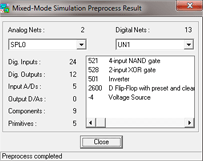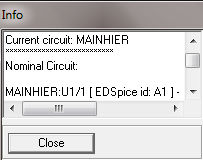Simulators
EDWinXP provides two types of simulators one is Mixed Mode Simulator and
other is EDSpice Simulator.
Mixed Mode Simulator

Simulation is a design analysis, which replaces design symbols with their
Simulation models and provides a detailed analysis of their behavior. For
Simulating a designed circuit, the model of the real circuit is created taking
all factors into consideration, and the appropriate inputs are given. Then the
outputs at each level are checked and corrections or modifications are made.
Hierarchical simulation has been implemented in EDWinXP Mixed Mode
Simulator.The simulator now supports simulation of hierarchical databases.
In addition to that, two new analysis has been introduced in Mixed mode
simulator that assist end users to design the circuit precisely.
 How to Prepare the circuit for Simulation?
How to Prepare the circuit for Simulation?
Monte Carlo analysis is used to calculate component parameter values for a
given output at a given instant of time. Sensitivity analysis points out the
most sensitive component to a particular parameter such as voltage, current,
etc. During simulation all factors are taken into consideration and a model of
the real circuit is created and the inputs are given accordingly. Then the
outputs at each level are checked and corrections or modifications, if any, are
made. There are a number of algorithms used universally to simulate a circuit.
The Mixed-Mode Simulator is one of the best tools used. It can simulate analog,
digital as well as a combination of analog-digital circuits. It is a de facto
that an analog simulator equipped with a logic simulation engine that models the
digital parts of a circuit during the Transient Analysis run. The commonly used
functions by the simulator are: Bias point calculation, Transient
analysis, Parameter sweep analysis, DC Sweep Analysis, AC Sweep Analysis, Monte
Carlo Analysis, Sensitivity Analysis, Preprocessing pass.
 Bias Point Calculation
Bias Point Calculation
 Transient Analysis
Transient Analysis
 Parameter Sweep Analysis
Parameter Sweep Analysis
 AC Sweep Analysis
AC Sweep Analysis
 Monte Carlo Analysis
Monte Carlo Analysis
 Sensitivity Analysis
Sensitivity Analysis
EDSpice Simulator

The EDSpice Simulator is a plug-in extension of the EDWin Electronics
CAD/ CAE System. It provides EDWin users with the facility to analyze and
validate the functionality and behavior of circuits captured in the form of
schematic diagrams. The EDSpice Simulator is based on SPICE 3F5 and
XSPICE with a number of extensions and improvements. SPICE 3F5 was developed
by the University of California and XSPICE was developed by Georgia Tech
Research Institute.
 How do we analyse the circuit using EDSpice Simulator?
How do we analyse the circuit using EDSpice Simulator?
 Small Signal AC Analysis
Small Signal AC Analysis
 Transient Analysis
Transient Analysis
SPICE is well known in the electronics industry as a general-purpose
circuit simulation program for nonlinear dc, nonlinear transient and linear ac
analyses. XSPICE extends SPICE3's capabilities to allow simulation of
mixed-signal (analog/digital) and mixed-level circuits. EDSpice is a
separate product and must not be confused with EDWinXP's current Mixed Mode
Simulator Apart from simulating circuits captured using the editing functions of
the EDWinXP Schematic Editor package, experienced SPICE users may simulate
circuits generated by other CAD/ CAE packages, capable of producing netlists
complying with the Berkeley SPICE2G.6 format. An additional feature
allows you to recreate the schematic part of EDWinXP's circuit projects, by
importing files in the above-mentioned standard. SPICE netlist or input files
(.CIR) generated by EDWinXP (function of EDSpice Simulator interactive module)
are fully compatible with the Berkeley standard. This means that circuits
captured in EDWinXP may be simulated by any third party SPICE simulator.